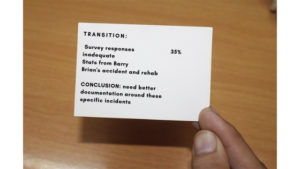Do you use a full script or feel like you have to read your presentation? Is one of your goals to learn how to use few – or no – notes when presenting?
It can be important for many people, particularly in certain industries, to show their expertise in this way.
I personally see notes – whether they’re bullet points jotted on a cue card or an A4 sheet of paper – as a safety net. Something that allows you to get back on track if you get distracted or thrown.
Or if you have a mind blank or brain freeze..the kind of horrible event that can be hard to come back from: having something written down to get you back on track is very reassuring.

However: if my argument that notes can be a good thing doesn’t convince you, and you think it looks unprofessional or impossible for your situation, then with practice you can certainly learn to reduce or eliminate notes!
And if you’re someone who basically reads a script and barely looks up, then learning to use brief notes is going to be a good move.
When we can only see the top of your head as you read, or you drop into a bit of a drone vocally – this is not an engaging experience for your audience, as you know! Plus it’s incredibly time-consuming to create a script each time. And eventually, probably unachievable.
So if you want to fix this, and either just use your slides as cues, or cue cards, you need to break the process down into a series of steps:
First – simple version:
If you do have a script with your whole presentation written out, aim for this the next time you speak: cull your notes down to one page.
And if/when you’re comfortable enough with that, cull again in a future talk to half a page of bullets.
The next stage: just five bullets for example, using full sentences.
Then just five words on one cue card.
Finally – and only if you think this is a good idea – no notes at all. (Remember this though: if you do get lost, you’ll need a contingency plan for how you’ll recover.)
Second – more detailed version:
This applies whether you’ve got a fully written-out script or key messages in detail.
Make sure you’ve divided your ideas up into clear and separated points or chunks of content. If you can’t separate your points clearly enough in your own mind, you’ll have trouble recalling them. (Unless you use slides to prompt you of course).
Highlight the keywords from each point or chunk of material and then run through it still using the full sentences that you’ve written or the script. Focus on the keyword specifically as you do so. You need to do this a number of times, and practising out loud is crucial.
Start deleting words and leave only the highlighted or circled keywords or phrases. Again you need to practise – preferably aloud – using your keywords as reminders. You’re still using the same piece of paper at this point.
Write your keywords and any additional triggers needed on cue cards or a fresh sheet of paper. Your final step is to practise your talk aloud using only the cue cards as your aid.
So if one of your goals is to learn how to use few or no notes when presenting, I hope you find this useful to prepare.
Best wishes with your speaking!

Leave a Reply